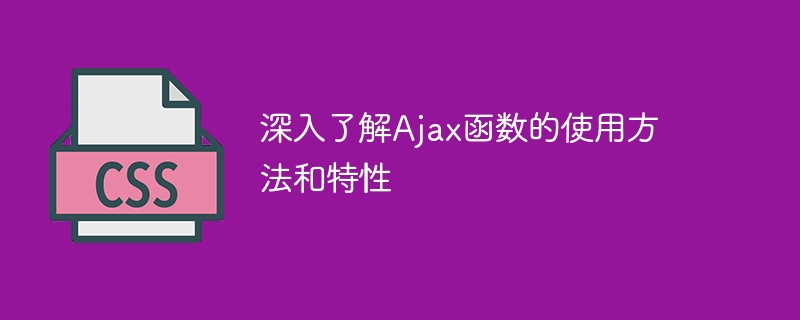

In-depth understanding of the usage and characteristics of Ajax functions requires specific code examples
Introduction:
In modern Web development, Ajax (Asynchronous JavaScript and XML ) has become a very common and useful technique. Ajax uses a combination of JavaScript and XML (or JSON) to communicate asynchronously with the server without refreshing the entire page. This article aims to introduce in depth the usage and characteristics of Ajax functions and give specific code examples.
1. Basic usage of Ajax functions:
To use Ajax functions, you need to create an XMLHttpRequest object first, and then use the object to send HTTP requests and process responses. The following is a sample code for the basic usage of the Ajax function:
function ajax(method, url, data, success) {
var xhr = new XMLHttpRequest(); // 创建XHR对象
xhr.open(method, url, true); // 配置请求
xhr.onreadystatechange = function () {
if (xhr.readyState === XMLHttpRequest.DONE) { // 请求已完成
if (xhr.status === 200) { // 成功响应
success(xhr.responseText); // 处理响应
} else {
// 处理错误
}
}
};
xhr.send(data); // 发送请求
}The sample code for using the above ajax function is as follows:
ajax('GET', 'http://example.com/api/data', null, function(response) {
console.log(response);
});The above code uses the GET method to request 'http://example.com/ api/data' interface, and output the response result to the console after the request is successful.
2. Characteristics of Ajax function:
The following is a sample code that uses the Ajax function to obtain data asynchronously and update the page content:
var resultElement = document.getElementById('result');
ajax('GET', 'http://example.com/api/data', null, function(response) {
var data = JSON.parse(response); // 解析JSON响应
resultElement.innerHTML = '数据:' + data.name; // 更新页面内容
});
The above code sends a GET request to obtain data through the Ajax function, and updates after the request is successful. The content of the element with id 'result' on the page.
Summary:
By having an in-depth understanding of the usage and characteristics of Ajax functions, we can better utilize Ajax to implement various functions. Ajax's features such as asynchronous communication, cross-domain requests, and exception handling allow us to process data and update page content more flexibly. I hope that through the introduction and sample code of this article, readers can better understand the use of Ajax functions and can flexibly apply them in their own projects.
The above is the detailed content of In-depth understanding of the usage and characteristics of Ajax functions. For more information, please follow other related articles on the PHP Chinese website!




